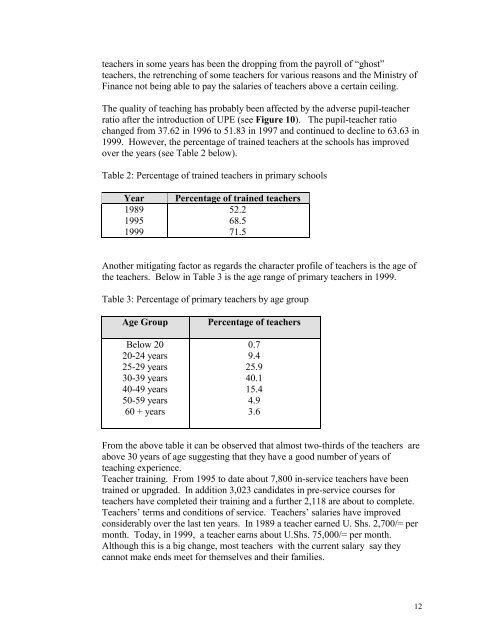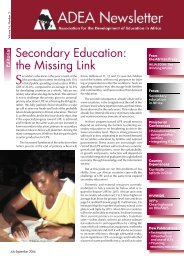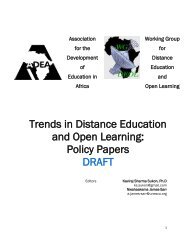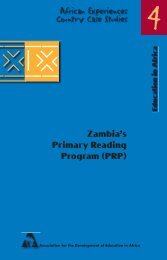the ugandan experience of universal primary education (upe) - ADEA
the ugandan experience of universal primary education (upe) - ADEA
the ugandan experience of universal primary education (upe) - ADEA
You also want an ePaper? Increase the reach of your titles
YUMPU automatically turns print PDFs into web optimized ePapers that Google loves.
teachers in some years has been <strong>the</strong> dropping from <strong>the</strong> payroll <strong>of</strong> “ghost”<br />
teachers, <strong>the</strong> retrenching <strong>of</strong> some teachers for various reasons and <strong>the</strong> Ministry <strong>of</strong><br />
Finance not being able to pay <strong>the</strong> salaries <strong>of</strong> teachers above a certain ceiling.<br />
The quality <strong>of</strong> teaching has probably been affected by <strong>the</strong> adverse pupil-teacher<br />
ratio after <strong>the</strong> introduction <strong>of</strong> UPE (see Figure 10). The pupil-teacher ratio<br />
changed from 37.62 in 1996 to 51.83 in 1997 and continued to decline to 63.63 in<br />
1999. However, <strong>the</strong> percentage <strong>of</strong> trained teachers at <strong>the</strong> schools has improved<br />
over <strong>the</strong> years (see Table 2 below).<br />
Table 2: Percentage <strong>of</strong> trained teachers in <strong>primary</strong> schools<br />
Year Percentage <strong>of</strong> trained teachers<br />
1989<br />
1995<br />
1999<br />
52.2<br />
68.5<br />
71.5<br />
Ano<strong>the</strong>r mitigating factor as regards <strong>the</strong> character pr<strong>of</strong>ile <strong>of</strong> teachers is <strong>the</strong> age <strong>of</strong><br />
<strong>the</strong> teachers. Below in Table 3 is <strong>the</strong> age range <strong>of</strong> <strong>primary</strong> teachers in 1999.<br />
Table 3: Percentage <strong>of</strong> <strong>primary</strong> teachers by age group<br />
Age Group<br />
Below 20<br />
20-24 years<br />
25-29 years<br />
30-39 years<br />
40-49 years<br />
50-59 years<br />
60 + years<br />
Percentage <strong>of</strong> teachers<br />
0.7<br />
9.4<br />
25.9<br />
40.1<br />
15.4<br />
4.9<br />
3.6<br />
From <strong>the</strong> above table it can be observed that almost two-thirds <strong>of</strong> <strong>the</strong> teachers are<br />
above 30 years <strong>of</strong> age suggesting that <strong>the</strong>y have a good number <strong>of</strong> years <strong>of</strong><br />
teaching <strong>experience</strong>.<br />
Teacher training. From 1995 to date about 7,800 in-service teachers have been<br />
trained or upgraded. In addition 3,023 candidates in pre-service courses for<br />
teachers have completed <strong>the</strong>ir training and a fur<strong>the</strong>r 2,118 are about to complete.<br />
Teachers’ terms and conditions <strong>of</strong> service. Teachers’ salaries have improved<br />
considerably over <strong>the</strong> last ten years. In 1989 a teacher earned U. Shs. 2,700/= per<br />
month. Today, in 1999, a teacher earns about U.Shs. 75,000/= per month.<br />
Although this is a big change, most teachers with <strong>the</strong> current salary say <strong>the</strong>y<br />
cannot make ends meet for <strong>the</strong>mselves and <strong>the</strong>ir families.<br />
12

















